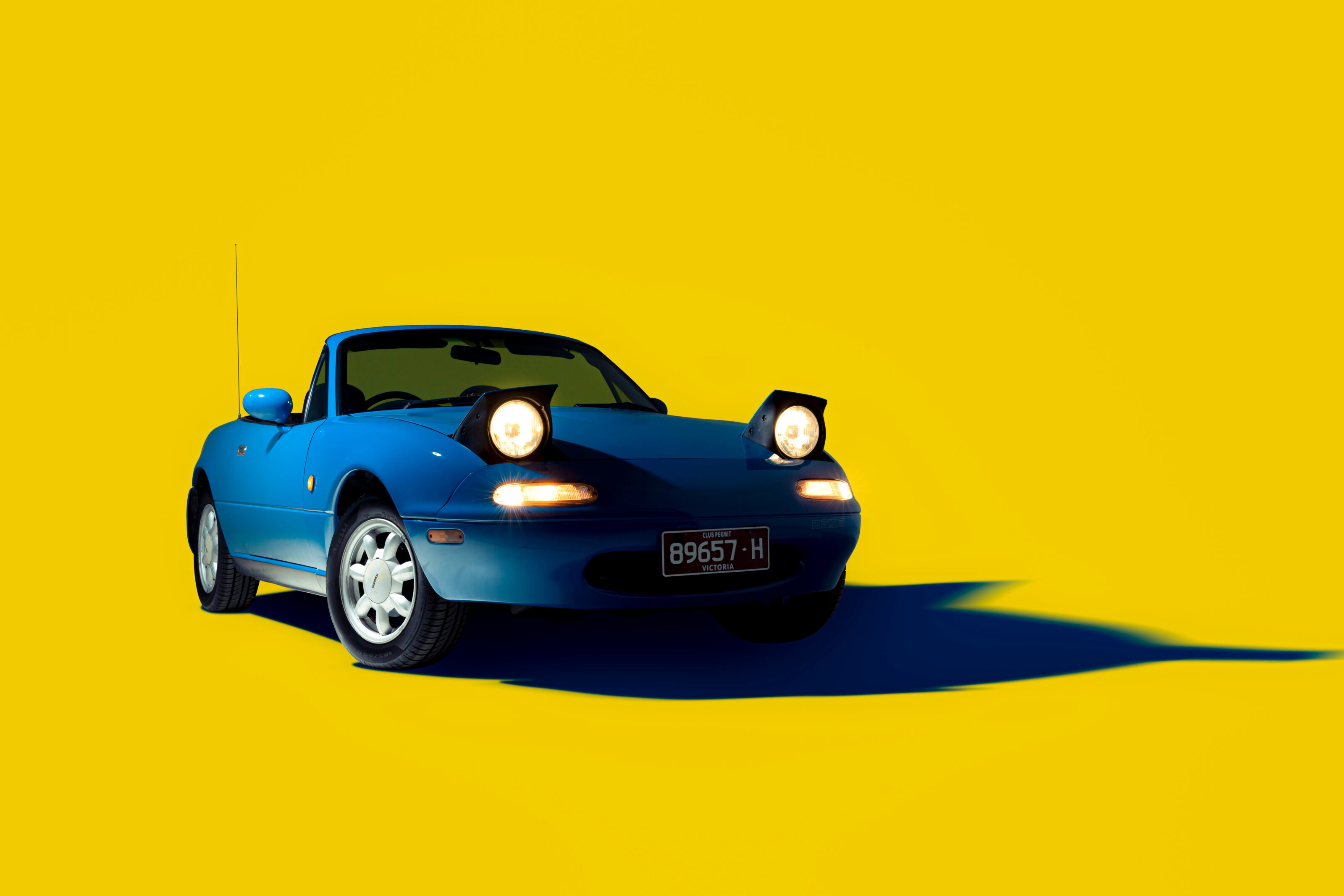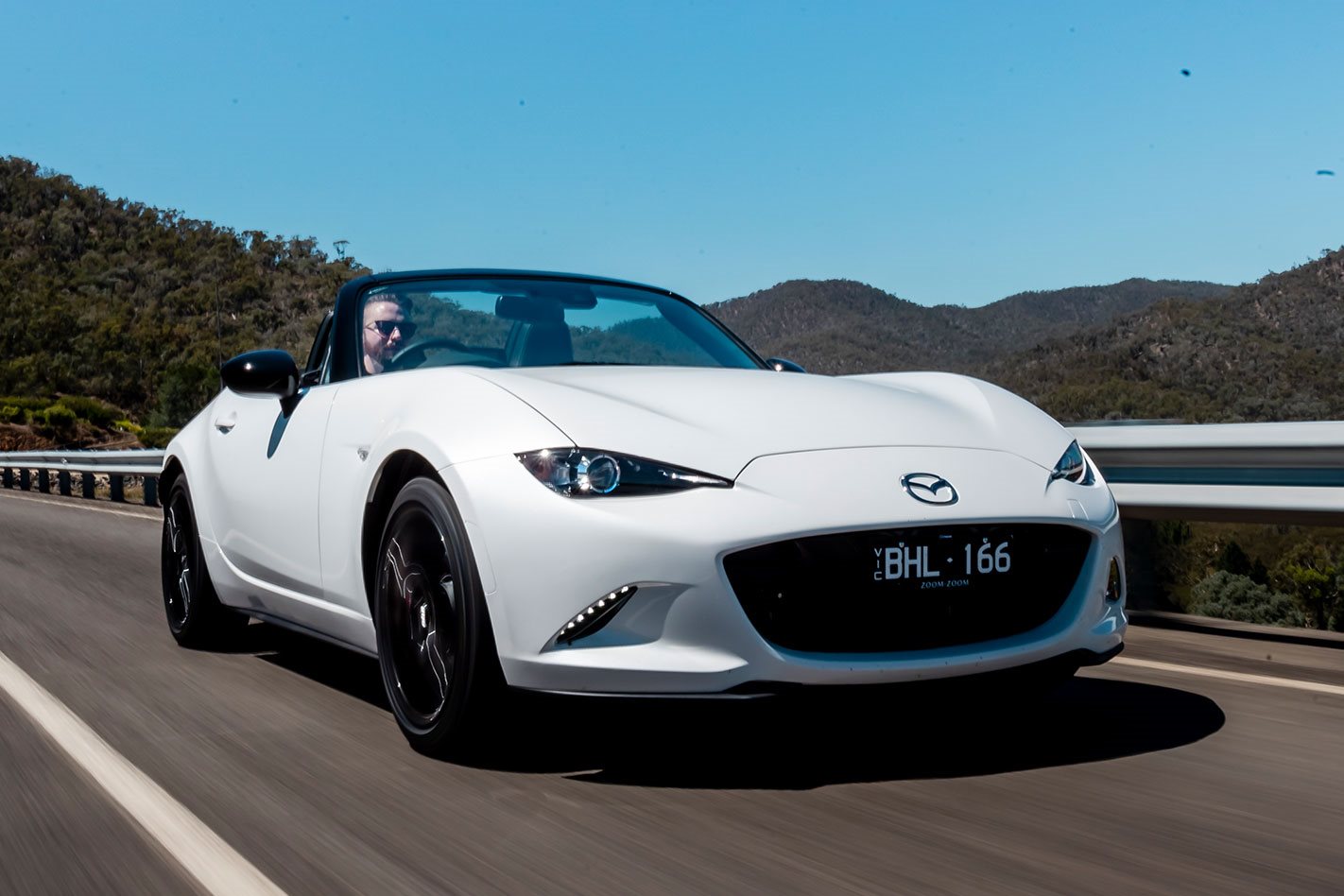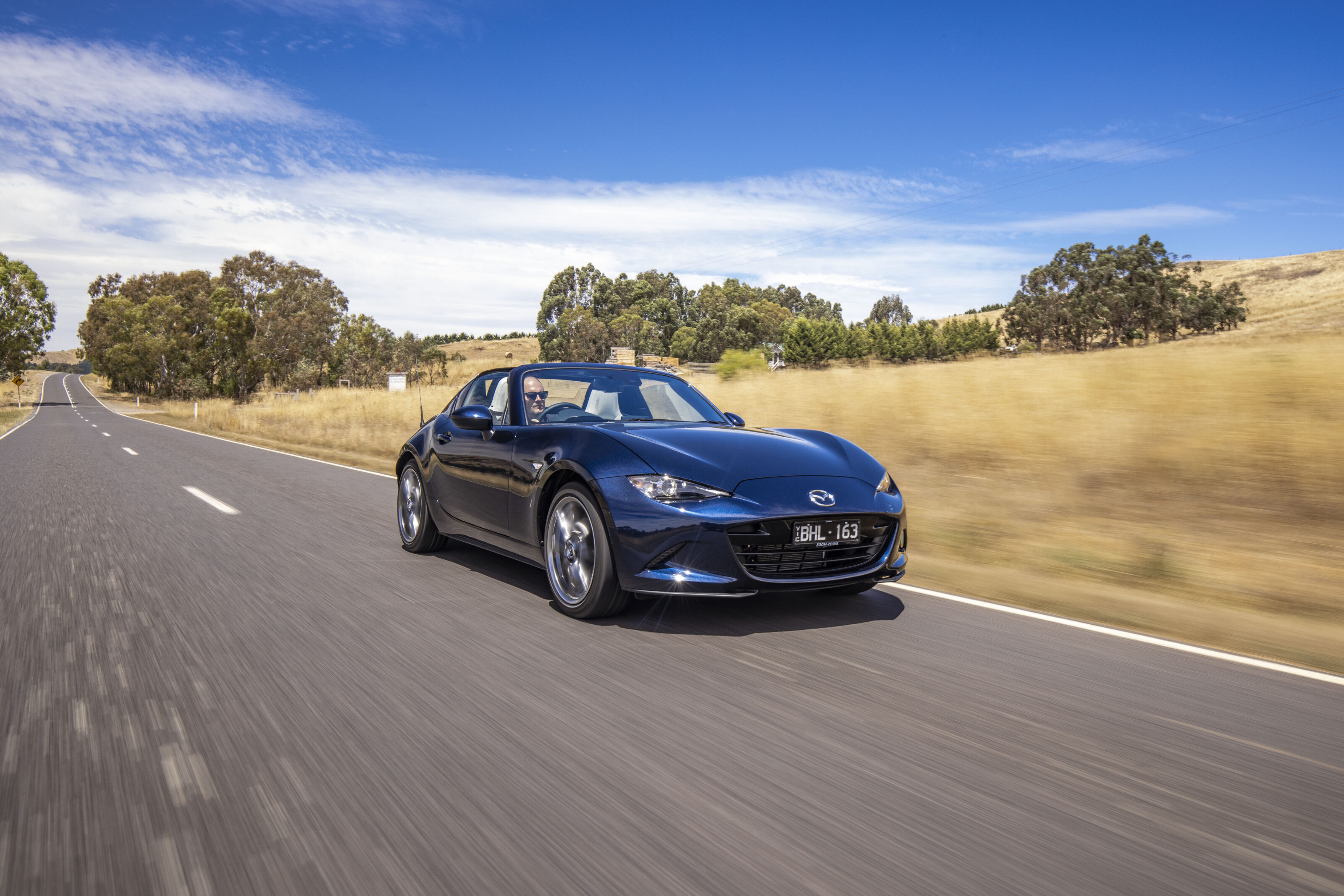I remember seeing the exact car pictured here – a manual-steer 1.6-litre NA MX-5, painted in the glamour launch colour, Mariner Blue – proudly gracing the showroom of our local Mazda dealer like a jewel glittering among swathes of beige.
Only the also-new BG-series 323 Astina with its pop-up headlights looked even vaguely on the same page as the curvaceously petite roadster. Alongside the boxy 626s and 929s of the era, however, not to mention the (also blue) 121 my mum ended up driving home, the MX-5 seemed outrageously, exquisitely exotic.
Yet underneath those Lotus Elan-inspired curves, the NA MX-5 was a relatively simple thing, much like the plethora of vintage roadsters that clearly inspired it. Except that the Japanese take on a British institution – a rear-drive, open-top two-seater – was actually good! Seriously good.

When the MX-5 debuted to a wildly enthusiastic audience in February 1989, the ‘affordable roadster’ hadn’t been dead that long. Both the MGB and Triumph Spitfire had creaked to their graves in 1980, and while the Alfa Spider was still in production, it was seriously ancient – 23 years old at that stage – and barely breathing. Not surprisingly, Mazda’s interpretation was decades ahead, and because it was so right to begin with, it still feels relatively modern.
The genesis of the MX-5 (or Miata, or Eunos Roadster, depending on where you live) began in 1978 during a conversation between Mazda’s then-chief engineer Kenichi Yamamoto and our very own Bob Hall, who worked at Wheels for almost a decade (until the early 2000s) but at the time was writing for Autoweek magazine in LA.
Hall planted a seed in Yamamoto-san’s brain by suggesting that Mazda should try its hand at a simple, affordable, sports roadster. Three years later, with Yamamoto as Mazda’s president, Hall joined the product-planning department and the journey towards developing a vehicle concept began.

By 1983, Mazda’s three main design centres (Hiroshima, Tokyo, and a brand-new studio in Irvine, California) were in direct competition with each other conceptualising what this roadster should be, with ideas spanning ultra-modern and front-drive (Hiroshima), much like the new Honda CRX, to mid-engined and rear-drive (Tokyo), like Toyota’s MR2. The Californian team, however, stuck to Hall’s original principle of a lightweight, front-engined sports car with rear-drive, which became the winning formula.
Tellingly, early photos show the first MX-5 prototype parked next to both a Triumph Spitfire 1500 and a Lotus Elan out on public roads in southern California, proving the British conceptual connection was indeed real, but they also show an oval front air intake – a design feature that would survive all the way to MX-5 production five years later.
This focus on soft-edged, organic forms was in complete contrast to the high-tech, ultra-trendy geometric designs of the time – the poster child being the super-cool (but also peak-80s) original W10 MR2 of 1984 – but Mazda’s designers felt the MX-5 needed to have an everlasting visual appeal.

“The [MX-5] Miata design had to be timeless and classic, which was essential in the initial concept,” wrote designer Mark Jordan in the US Miata magazine, very early in the NA MX-5’s life. “The design would have to wear well for at least 10 years and in the long run would have to get better with age.”
Yet the MX-5 project was far from a done deal. Many inside Mazda, including people in high-ranking positions, felt it simply wasn’t worth the effort and that the development funds were better spent elsewhere. But an equal number were very passionate about the car and could see its global potential.
Final approval eventually came in January 1986, after president Kenichi Yamamoto quietly encouraged every executive on the board of directors to give the project a green light. A final clay model was produced by combining the best aspects of the original 1984 design and a 1985 follow-up (characterised by its lower body height), and once this design was approved, it was sent to Japan to be refined into the production model, all under the direction of program manager Toshihiko Hirai.

As for the hardware underneath this lithe, sporting wrapping, Mazda initially tried to adapt the AWD 323/Familia’s independent rear end and differential, mated to an RX-7 gearbox, but the 323 suspension wasn’t low enough for the MX-5’s lean shape. This resulted in completely bespoke suspension architecture that would become the centrepiece of the MX-5’s excellence.
The brief was to produce a brilliant-handling sports car that could also serve as an effective race car, so a double-wishbone set-up – unequal-length wishbones up front with coil-over dampers, and upper A-arms with lower H-arms at the rear, also with coil-over dampers – was connected to front and rear subframes that were rubber-mounted to the body to reduce harshness, without affecting the car’s precision.
Riding on humble 185/60R14 tyres (with 14×5.5-inch alloys standard in Australia), the MX-5 did indeed offer a surprisingly liveable ride but it was the car’s balance and dynamic harmony that gifted it the accolades it so richly deserved. Its static weight distribution was 52/48 front-to-rear, but with two average-sized occupants, the NA MX-5 had almost bang-on 50/50 balance.

Combined with a feelsome manual steering system – a rigid rack running in needle roller yokes for reduced friction – with 3.3 turns lock-to-lock spanning a super-tight 9.3m turning circle, the MX-5 finally realised the promise of all the flawed roadsters that inspired it. A power-steered set-up arrived later in Australia, reducing steering effort to 2.8 turns, but the manual set-up has long been the purist preference. It’s the definition of everything the car stands for.
Writing for James L Bryant’s Mazda MX-5 Miata: Twenty-Five Years, designer Mark Jordan described the NA’s purity perfectly: “a design that was minimalist, lean, and lightweight looking, with a fun and animated personality, and a sprinkle of innocence. In other words, a simple, pure and honest approach”.
Ultimately, only the MX-5’s drivetrain featured DNA links to other Mazda models, though its relative simplicity maintained this purist ideal. The 1597cc B6-series engine was the same 1.6 that debuted in the second-gen 323 and KC Laser in 1985, but the MX-5’s B6-ZE twin-cam 16-valve version featured a 9.4:1 compression ratio, a lightened crankshaft and flywheel, and extractor-style exhaust headers to stretch its rev ceiling to 7200rpm.

Much-improved outputs of 85kW at 6500rpm and 130Nm at a steep 5500rpm were the result, though the NA MX-5 was never about numbers.
It was always about feel.
With super-crisp throttle response, a snickety-snick short-throw shift for Mazda’s M-type five-speed manual and a rasping exhaust note, the NA MX-5 made up for in spirit what it lacked in outright punch. Apparently, program manager Hirai made himself a 30-minute cassette tape of his favourite exhaust sounds to inspire him on his way to work, among them BMW’s classic M1 supercar.
Combining the drivetrain’s immediacy with terrific torsional body strength gifted the little MX-5 a shrink-wrapped, glove-like dynamic personality and a thoroughly modern polish that instantly dated every roadster before it.

And while Mazda refined the formula over time – particularly the 1994 1.8-litre version with standard power steering – it’s the manual-steer 1.6 that best encapsulates this car’s reason for being.
There’s also a beautifully subtle retro touch to the NA MX-5. Its exquisite chrome door handles, eyeball air vents, chrome-ringed analogue gauges, and minimalist dashboard evoked a flavour of the past without directly ripping it off. Even the engine’s naked twin rocker covers served as a fabulous reminder that sporting engines used to look good, too. Viewed from a 2021 perspective, these design flourishes seem uniquely MX-5 rather than a pastiche from the past.
What you do notice is just how compact the NA MX-5 is. While it’s kinda large compared to an original Lotus Elan, it’s not a big car.

At 3975mm long, riding on a teensy 2265mm wheelbase and standing just 1230mm tall, the NA MX-5 defines petite. Yet its 1675mm width and quite generous tracks give it a fantastic dynamic stance. It also weighs less than a tonne, with an aluminium bonnet aiding weight distribution.
The NA MX-5 proved such a breakthrough success – both critically and commercially – that it kick-started a whole wave of 1990s roadsters, among them the Porsche Boxster, which may never have existed had the MX-5 not reminded the Germans that an affordable roadster, taking some inspiration from Porsche’s long-forgotten 914 from the early-’70s, still held a special place in modern motoring.
Yet the NA MX-5 also had a profound effect inside its own stable. The fourth-generation ND of 2015 is essentially a post-modern re-imagining of the 1989 original – lighter, smaller, simpler, and sweeter – and the finest MX-5 in a long time. Indeed, after six years (and counting) it feels ageless, which surely validates the inherent rightness of the superb MX-5 original.

B-EATEN BY A MILE
When Mazda’s MX-5 launched, it was 27 years since MG had introduced what was once the world’s biggest-selling roadster of all time (the MGB), yet it’s now 32 years since the first MX-5! It only took 10 years for the little Mazda to smash the MG’s sales record of 523,836 units, with the NA making up almost half a million of that total, but it would take the MX-5 until 2016 to reach one million sales.
TINY TIN TOP
Mazda Australia offered an optional hardtop, as well as a standard soft-top with zip-out rear window (which was optional in other markets, and not always fitted to replacement hoods, as pictured here). The soft-top is reasonably hard-wearing, though the rear window does tend to become yellowy. As for current values, NA MX-5s have suddenly taken off, with what would’ve been a $5K car now approaching $15K. And counting.

Mazda NA MX-5 specifications
| Engine | 1597cc 4cyl, dohc, 16v |
| Max power | 85kW @ 6500rpm |
| Max torque | 130Nm @ 5500rpm |
| Transmission | 5-speed manual |
| Weight | 990kg |
| 0-100km/h | 9.1sec (claimed) |
| Price | (now) $10,000 u2013 $25,000 |







